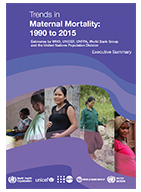Maternal mortality has fallen by 44% globally since 1990, according to a report released by UN agencies and the World Bank.
Despite global improvements, however, only nine countries achieved the Millennium Development Goal (MDG) 5 target of reducing the maternal mortality ratio (MMR) by at least 75% in this period.
The report stresses that the world needs to more than triple its pace of progress to achieve the Sustainable Development Goals (SDGs).
 12 November 2015: Maternal mortality has fallen by 44% globally since 1990, according to a report released by UN agencies and the World Bank. Despite global improvements, however, only nine countries achieved the Millennium Development Goal (MDG) 5 target of reducing the maternal mortality ratio (MMR) by at least 75% in this period. The report stresses that the world needs to more than triple its pace of progress to achieve the Sustainable Development Goals (SDGs).
12 November 2015: Maternal mortality has fallen by 44% globally since 1990, according to a report released by UN agencies and the World Bank. Despite global improvements, however, only nine countries achieved the Millennium Development Goal (MDG) 5 target of reducing the maternal mortality ratio (MMR) by at least 75% in this period. The report stresses that the world needs to more than triple its pace of progress to achieve the Sustainable Development Goals (SDGs).
‘Trends in Maternal Mortality: 1990-2015′ is the eighth and last in a series that has analyzed progress toward the MDG on maternal mortality. The World Health Organization (WHO), the UN Children’s Fund (UNICEF), the UN Population Fund (UNFPA), the World Bank and the UN Population Division contributed data for the report.
“Over the past 25 years, a woman’s risk of dying from pregnancy-related causes has nearly halved,” said Flavia Bustreo, WHO. She observed that the MDGs “triggered unprecedented efforts” to reduce maternal mortality.
Approximately 99% of global maternal deaths occur in developing regions, with 66% of them occurring in sub-Saharan Africa. Eastern Asia recorded the greatest improvement in its MMR, which fell 72%, from 95 to 27 per 100,000 live births. Sub-Saharan Africa’s MMR decreased nearly 45%, from 987 to 546 per 100,000 live births. Oceania’s MMR is 187 per 100,000 live births. Bhutan, Cabo Verde, Cambodia, Iran, Lao People’s Democratic Republic (Lao PDR), Maldives, Mongolia, Rwanda and Timor-Leste all achieved the MDG 5 target on reducing maternal mortality. An additional 39 countries are categorized as “making progress,” 21 countries have made “insufficient progress” and 26 have made “no progress.”
The Global Strategy for Women’s, Children’s and Adolescents’ Health aims to achieve the 2030 Agenda for Sustainable Development’s target 3.1 of reducing maternal deaths to fewer than 70 per 100,000 live births. To achieve this goal, the Strategy recommends: reinforcing country leadership by mobilizing domestic and international resources for women’s, children’s and adolescents’ health; strengthening health systems; and promoting collaboration across sectors. It calls for special attention during humanitarian crises and in fragile settings.
Other recommended interventions include: ensuring access to high-quality health services during pregnancy and child birth, including identifying and addressing potentially fatal conditions such as pregnancy-induced hypertension; practicing good hygiene to reduce infection risk; injecting oxytocin after childbirth to reduce severe bleeding risk; and ensuring access to sexual and reproductive health services. The report also recommends investing in the education of women and girls, particularly the most marginalized.
WHO also called for strengthening data and accountability to ensure complete, accurate registration systems of births, deaths and causes of death, with the aim of preventing similar deaths. [WHO Press Release] [Publication: Trends in Maternal Mortality: 1990 to 2015] [Executive Summary]